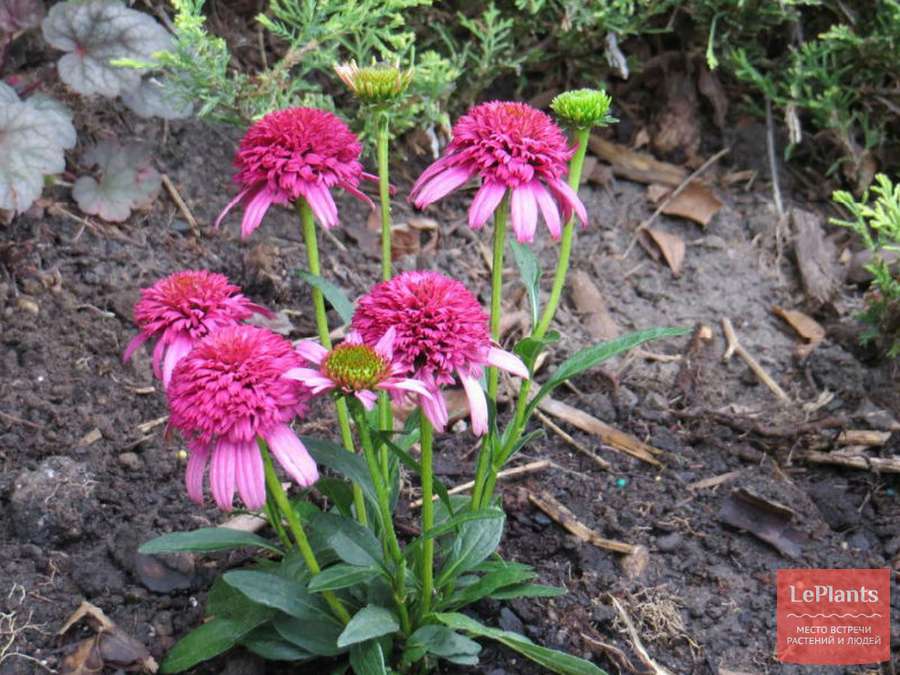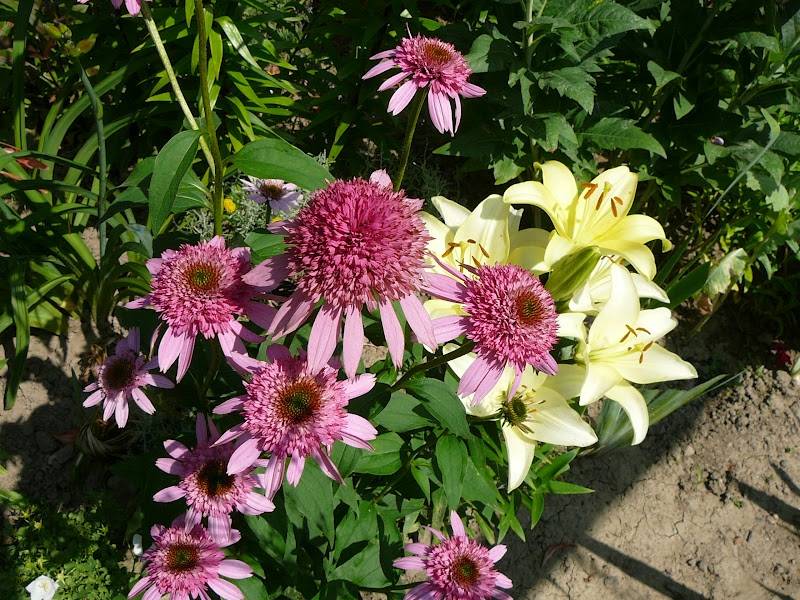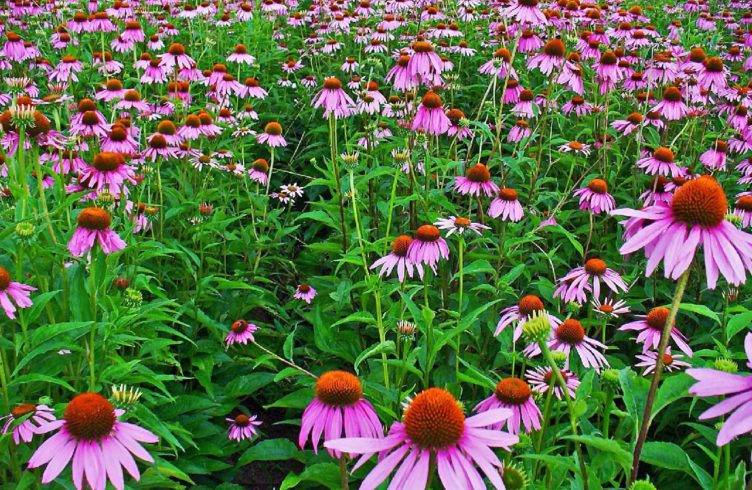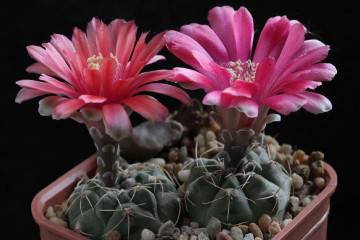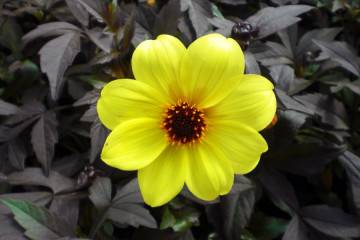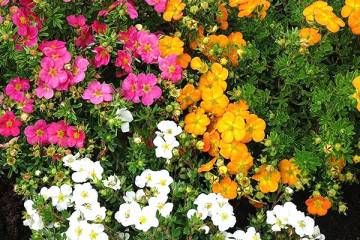Echinacea purpurea and other plant varieties
Content:
Echinacea purpurea is one of the most beautiful plants in the large Astrov family. Distributed throughout the world from North America, this flower has won the hearts of many gardeners - thanks to its varietal variety, an excellent combination with other garden crops. The plant is unpretentious, however, in order to ensure its normal growth and development, you should learn everything about planting Echinacea purpurea in open ground and caring for it.
The origin and appearance of echinacea
The homeland of echinacea is the eastern part of the United States of America; the plant appeared in European gardens only 300 years ago. The flower belongs to the Astrov family, it was first described by Karl Linnaeus. He considered that the plant belongs to the genus Rudbeky. 41 years later, in 1794, the botanist Mönch isolated the plant as a separate genus. The name of the flower can be translated from Greek as "prickly".
The plant is common in the steppes and rocky hills. The Indians knew about its healing power - they grew echinacea almost on an industrial scale!
Echinacea flower description
Echinacea is a flower that can reach a height of about one and a half meters. The stem of the plant is rather rough, rough, the leaves are wide, tapering towards the ends. The appearance of the inflorescences resembles a chamomile, while the petals can have different shades:
- red;
- white;
- pink;
- yellow.
The flowers are ligulate, single-row, collected in single inflorescences. The diameter of one flower usually does not exceed ten centimeters. Fruits are achenes, their ripening occurs in August-September.
Flowering begins in the second half of July and lasts up to two months.
Echinacea: perennial flower
In general, there are five known species of herbaceous plants, called echinacea, but the stable and effective perennial Echinacea purpurea has become widespread in horticulture.
Benefits of Echinacea
The flower looks great in landscape-type flower beds. It can be the main accent, or it can play the role of a background for other plants. Having planted echinacea on his site, the gardener gets a unique plant for which there are many uses!
Application in traditional medicine
The main beneficial property of echinacea is its healing effect on the human body. All parts of the plant contain various vitamins, essential oils, resins, organic acids, and minerals. Separately, it should be said about the presence of such antioxidants as echinocin and echinolone.
This means that Echinacea (flowers, leaves and roots) has the following effects:
- antimicrobial;
- antiviral;
- immunostimulating;
- wound healing.
Echinacea is indicated for obesity, infertility, it relieves cravings for alcohol and smoking. Of course, you can use any parts of the plant only after consulting a doctor!
Speaking about useful properties, the following should be noted:
- improved blood composition;
- normalization of blood clotting;
- the formation of healthy tissue after surgery;
- increased immunity;
- improved metabolism;
- restoration of mental health;
- getting rid of tonsillitis and tonsillitis;
- fast wound healing.
Use in garden design
The plant looks best in the background, it can be planted next to yarrows, dahlias, phlox and other ornamental crops. A good perennial in combination with conifers, suitable for creating rustic compositions in the garden.
Other types and varieties of echinacea
Echinacea is a flower that, in addition to its purple appearance, has a number of other varieties and varieties. For example, in the wild, there are nine species.
Echinacea Hot Papaya
This variety will appeal to those gardeners looking for plants that can become a bright accent. In the middle of summer, orange-red flowers emerge on the stems, crowned with large double pompoms that have the color of papaya.
This variety has a rich aroma, and its petals do not fade even in the hottest sunny summer.
Echinacea Ayherb
Echinacea Ayherb differs from other varieties in a delicate pinkish tint. The average diameter of the flowers is about 10 centimeters, the height of the plant reaches 80 centimeters.
Echinacea Eccentric
Echinacea Eccentric can be called one of the most outstanding varieties. On elastic and strong stems, the height of which reaches 60 centimeters, in the second half of July, double flowers of a bright red hue with a rich purple tint appear. At the end of summer, the flowers take on an orange tone.
Echinacea White
Echinacea White is a perennial plant that can reach 80 centimeters in height. As the name suggests, the petals are white. By the way, it is this echinacea that has the highest healing properties.
Echinacea yellow
Yellow Echinacea has some of the largest flowers. They are colored deep yellow. The heart of each inflorescence has a pleasant chocolate shade. In order for the plant to develop and grow normally, it needs loose, drained soil and open, sunny places.
Echinacea Milkshake
Large flowers are also typical for Echinacea Milkshake. Outwardly, they resemble large pom-poms with a light green tint. The middle part of the flowers is orange, the edges of the petals are pale white. The Milkshake Echinacea shrub can grow up to one and a half meters.
Echinacea Guava
Due to the fact that the growth of Echinacea of this variety reaches 100 centimeters, it is excellent for growing in flower beds and in a mixborder. The flowers are large, double, with bright red petals. Sometimes a purple hue can be seen at the base of the flower.
Also, the following varieties of Echinacea are popular among gardeners:
- Butterfly is a flower with a brown core and pink petals.
- Burgundy - as the name implies, the flowers of this variety of Echinacea are colored in the color of Burgundy wine.
- Fruit jelly - flowers have a bright orange tint.
- Red hat - with pink petals and a bright scarlet core.
- Twister - with a lilac-greenish tint of petals.
All of these varieties are good both as a single bush and in combination with other ornamental horticultural crops.
Echinacea purpurea: planting and care in the open field
Having decided to plant echinacea on your site, it is important to understand that in the first year of life it is hardly possible to see flowers - during this time, only a rosette will form.The plant will bloom only in the second year. Planting a perennial is a simple procedure.
How and when to plant echinacea
The optimal time for planting seedlings in a permanent place in the open field is autumn or spring. The site should be sufficiently sunny, with a nutritious neutral or slightly alkaline soil. Echinacea does not like light sandy soil or moist soil.
Step-by-step planting process
How to properly plant seedlings in a permanent place:
- Prepare the holes - their depth should be about five centimeters. It is important to keep the distance between them - about 30 cm. The depth of the hole should slightly exceed the length of the plant's root system.
- Place a small amount of compost on the bottom of the hole.
- Plant echinacea.
- Water the plant thoroughly.
In the event that Echinacea grew in a container, the planting hole should be slightly larger, the optimal depth is 40 cm. It should be filled in one third with a mixture of equal parts of sand, compost and garden soil.
Echinacea Garden Care
Echinacea is a completely unpretentious flower to care for. However, a small amount of attention will still have to be paid to the plant.
Watering mode
The flower should be watered in the evening. Purple Echinacea needs abundant and frequent moisture in the soil. In order to retain moisture at the roots, it is recommended to mulch the soil.
Top dressing
Echinacea is an herb that needs nutrients in its second year. Before flowering, you should feed the plant with rotted compost, you can also add wood ash. This will make the bloom more lush. Experienced growers recommend feeding flowers before flowering and after the plant has faded.
Features of care during flowering
During the flowering period, special complexes of mineral fertilizers should be applied. If you plan to use the flower for medicinal purposes, you should refuse to make additional fertilizing.
What to do when flowering is over
After the echinacea finishes flowering, you need to prepare it for winter. To do this, remove the inflorescences, cut off the shoots, cover the bushes with spruce branches or non-woven material.
Preparing for winter
Echinacea is a perennial that is frost-resistant. However, if not enough snow falls in winter, the flower may freeze and die. In order to prevent this, in the last days of October, all shoots should be cut off from the plants. Thoroughly sprinkle the root collar with mulch and cover with dry foliage or spruce branches on top.
All methods of breeding echinacea
In order to grow echinacea on the site, you can use one of two methods of flower reproduction - vegetative or growing from seeds.
Echinacea propagation by dividing bushes
This method is suitable for plants that are about 2-4 years old. It is recommended to divide the bush in early spring. To do this, you need to dig up the plant, divide it into the required number of parts, each of which must have adventitious roots and a bud. After that, the shoots are placed in a growth stimulator, and then planted in a permanent place.
Growing echinacea from seeds
Echinacea is fairly easy to propagate by seed. They can be planted in pre-prepared containers or directly into open ground.The seeds can be purchased at a specialized store, or can be harvested by hand - at the end of the season from baskets that have a dark shade.
In order for the flowers to bloom in the first year, the seeds should be sown no later than the beginning of February.
The planting material must be carefully sorted out and dried; it is recommended to plant it at the end of February. In a container with a universal substrate, it is necessary to sow seeds, the optimum depth is five millimeters. From above it is necessary to sprinkle them with a thin layer of ordinary sand - no more than one millimeter, and then moisten with a spray bottle. Cover containers with foil and place in a warm place. The first shoots will appear in one and a half to two months.
Plant diseases and pests
Experienced gardeners say: Echinacea purpurea is resistant to disease and pest attacks. The emergence of problems is possible only due to non-observance of the rules of agricultural technology and climatic conditions.
On hot summer days, the plant can get sick with powdery mildew. It is quite easy to detect this: a white bloom will appear on the echinacea. It is necessary to process flowers with Bordeaux liquid.
Sometimes small spots appear on the leaf plates, the plants begin to wilt. Most likely, these are fungal diseases such as cercosporosis and septoria, which will help to cope with various fungicides.
The appearance of bugs, slugs and other insects is possible. As for slugs, they must be collected by hand; insecticidal preparations can be used against any other insects.
Flower growing tips from experienced gardeners
Experienced flower growers recommend adhering to the following rules:
- Echinacea can be grown in the same place for no more than 5 years. After this, the plants should be dug up, divided into several bushes and planted in new places.
- Before planting, it is necessary to prepare the substrate: for this, combine garden soil, compost and river sand in equal parts. With this composition, it is necessary to fill the plant wells by a third.
- It is not enough just to sow the seeds - they need constant moisture, otherwise they simply will not sprout.
- For the winter, Echinacea purpurea is recommended to be covered with a pre-prepared oak leaf.
There is nothing difficult in planting and caring for echinacea. On top dressing, timely removal of weeds and watering, it will react with lush bright flowering. In addition, all parts of the flower contain useful substances, which is a pleasant addition to its attractive appearance.

